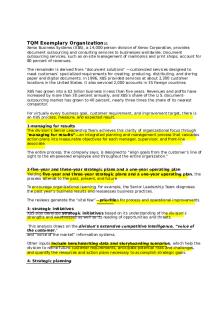Case study summary PDF

| Title | Case study summary |
|---|---|
| Course | Total Quality Management |
| Institution | Shandong University |
| Pages | 2 |
| File Size | 57.5 KB |
| File Type | |
| Total Downloads | 98 |
| Total Views | 198 |
Summary
Case study and summary for chapter 1...
Description
TQM Exemplary Organization21 Xerox Business Systems (XBS), a 14,000-person division of Xerox Corporation, provides document outsourcing and consulting services to businesses worldwide. Document outsourcing services, such as on-site management of mailrooms and print shops, account for 80 percent of revenues. The remainder is derived from “document solutions” —customized services designed to meet customers’ specialized requirements for creating, producing, distributing, and storing paper and digital documents. In 1996, XBS provided services at about 2,300 customer locations in the United States. It also serviced 2,000 accounts in 35 foreign countries. XBS has grown into a $2 billion business in less than five years. Revenues and profits have increased by more than 30 percent annually, and XBS’s share of the U.S. documentoutsourcing market has grown to 40 percent, nearly three times the share of its nearest competitor. For virtually every business goal, customer requirement, and improvement target, there is an XBS process, measure, and expected result. 1-managing for results The division’s Senior Leadership Team achieves this clarity of organizational focus through “managing for results”—an integrated planning and management process that cascades action plans into measurable objectives for each manager, supervisor, and front-line associate. The entire process, the company says, is designed to “align goals from the customer’s line of sight to the empowered employee and throughout the entire organization.”
2-five-year and three-year strategic plans and a one-year operating plan Yielding five-year and three-year strategic plans and a one-year operating plan, the process attends to the past, present, and future. To encourage organizational learning, for example, the Senior Leadership Team diagnoses the past year’s business results and reassesses business practices. The reviews generate the “vital few”—priorities for process and operational improvements. 3- strategic initiatives XBS also develops strategic initiatives based on its understanding of the division’s strengths and weaknesses as well as its reading of opportunities and threats. This analysis draws on the division’s extensive competitive intelligence, “voice of the customer,” and “voice of the market” information systems. Other inputs include benchmarking data and storyboarding scenarios, which help the division to refine future customer requirements, anticipate potential risks and challenges, and quantify the resources and action plans necessary to accomplish strategic goals. 4- Strategic planning
Strategic planning generates a “strategy contract,” priorities for investment, and business partnership plans. These are distilled into a human resources plan, an investment plan, and operational plans for each organizational customer account, and employee. 10-Step Selling Process Through XBS’s 10-Step Selling Process , on-site services are customized to meet the unique needs of each account. Dedicated account teams develop “standards of performance” according to customer service priorities. These standards, which XBS pledges to meet through its “total satisfaction guarantee,” are formalized in operations handbooks developed specifically for each customer. In addition to leading its competitors in overall customer satisfaction, the XBS division tops the industry in seven of the ten high motivators of customer satisfaction. Performance in all four key categories of customer requirements continues to improve; average scores in 1996 ranged from 8 to 9 on a 10-point grading scale. Employee satisfaction has increased from 63 percent in 1993 to 80 percent in 1996, which is significantly higher that the average for a peer group of companies....
Similar Free PDFs

Case study summary
- 2 Pages

Discharge Summary - Case Study
- 2 Pages

Tesco-Case-Study - Case Study
- 3 Pages

Carmichele Case - case summary
- 53 Pages

CASE summary - Case summarisa
- 3 Pages

This was a case study summary
- 5 Pages

Case summary
- 70 Pages

Case summary
- 2 Pages

Case 7 - Case Study
- 1 Pages
Popular Institutions
- Tinajero National High School - Annex
- Politeknik Caltex Riau
- Yokohama City University
- SGT University
- University of Al-Qadisiyah
- Divine Word College of Vigan
- Techniek College Rotterdam
- Universidade de Santiago
- Universiti Teknologi MARA Cawangan Johor Kampus Pasir Gudang
- Poltekkes Kemenkes Yogyakarta
- Baguio City National High School
- Colegio san marcos
- preparatoria uno
- Centro de Bachillerato Tecnológico Industrial y de Servicios No. 107
- Dalian Maritime University
- Quang Trung Secondary School
- Colegio Tecnológico en Informática
- Corporación Regional de Educación Superior
- Grupo CEDVA
- Dar Al Uloom University
- Centro de Estudios Preuniversitarios de la Universidad Nacional de Ingeniería
- 上智大学
- Aakash International School, Nuna Majara
- San Felipe Neri Catholic School
- Kang Chiao International School - New Taipei City
- Misamis Occidental National High School
- Institución Educativa Escuela Normal Juan Ladrilleros
- Kolehiyo ng Pantukan
- Batanes State College
- Instituto Continental
- Sekolah Menengah Kejuruan Kesehatan Kaltara (Tarakan)
- Colegio de La Inmaculada Concepcion - Cebu






